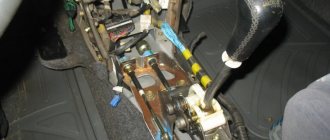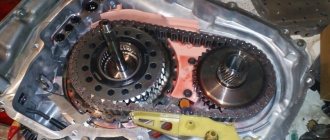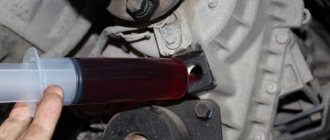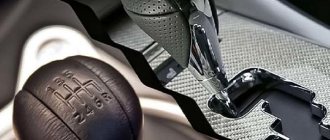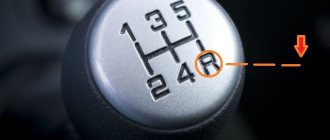gears
24.08.2020
no comments
229965
Cars with a manual transmission have many advantages over cars with an automatic transmission. They are more difficult to operate, but the cost of their repair is much lower compared to an automatic machine. In addition, if you learn to use a manual transmission, then an automatic car will seem very easy to drive. Today we’ll look at what a manual transmission is and how to learn how to operate it.
How to drive a manual transmission.
In the United States, the share of new cars sold with a manual transmission is only 6%. Therefore, many American drivers find driving a car with a manual transmission very difficult. So many drivers in the USA and not only are accustomed to driving vehicles with automatic transmission. In our country, the share of cars sold with a manual transmission is still slightly larger than with an automatic transmission, although driving a car with a manual transmission causes certain difficulties for many drivers. Dear motorists, our online publication has prepared for all motorists the so-called instructions and a small guide to it, which will (we hope) help drivers learn how to drive a car with a manual transmission.
Cars with a manual transmission (MT) are usually cheaper than cars with an automatic transmission. But driving a vehicle with this gearbox will not only allow you to save money when purchasing it, but will also open up a completely new world of driving for you (every driver).
Note that many high-performance sports cars are still equipped with manual transmissions. And when buying even an inexpensive and not very powerful car, it significantly allows you to reduce certain fuel costs, since this car, equipped with a manual transmission, consumes much less fuel than a car equipped with an automatic transmission.
What other advantages do a car with a manual transmission have over a car equipped with an automatic transmission? It is believed that such a manual transmission is much more reliable than an automatic transmission, and besides, the cost of repairing a manual transmission is always less than repairing a relatively complex automatic transmission.
Plus, driving a car with a manual transmission in winter is much safer than driving a car with an automatic transmission.
Subtleties and nuances when driving a car with a manual transmission
First of all, when you start to slow down in a car, do not forget that when the speed decreases significantly, you must depress the clutch. Without this, after characteristic twitching, the car engine will stall in gear.
It is also worth noting that in case of slight braking, it is permissible not to depress the clutch, but only if the correct relationship between the driving speed and the selected gear is not violated.
You can also influence the braking process using the gearbox (by downshifting). In fact, by lowering the gear, it is possible to reduce the speed, and in some cases it is possible not to use the brake pedal at all in certain conditions.
For this type of braking, the following must be taken into account:
- to reduce the speed of the car, you must stop pressing the gas pedal;
- go from a high gear to a low gear, while pressing the clutch (for example, go from fifth gear to fourth);
- Gradually reduce the speed, moving from the highest gear to the lowest. Follow this principle until you reach the first gear.
In order to practice this method of braking a car, a large area will be required. To find out what gear and speed you have, just look at the scales of the measuring instruments (tachometer and speedometer).
For example, at the moment when second gear is engaged, and the arrow on the tachometer has approached the red zone (red stripes), in this case you need to switch to third gear. If the speed is low (below 1800 thousand rpm), and the gear is fourth, then it is worth reducing the gear to third.
In any case, each car is different in engine type, power, weight, etc. In this case, the following ratios of speed and gears can be considered as an average indicator:
- First gear: 0 – 20 km/h;
- Second gear: 20 - 40 km/h;
- Third gear: 40 – 60 km/h;
- Fourth gear: 60 – 80 km/h;
- Fifth gear: 80 km/h and more;
- Sixth gear (not available on all manual transmissions) - 100 km/h or more.
If your car's speed is high enough, then the transition from low to high will occur smoothly. However, when switching “down” you need to remember that this will lead to a slowdown. Moreover, if you switch at high speed, for example, from fifth to second, this can lead to a sharp deceleration, skidding, and breakdown of the gearbox and engine.
By the way, a manual gearbox is different from other gearboxes, allowing you to switch to neutral at any time. This is useful if the car is going downhill. The driver can simply shift to neutral, the car will roll down at random, but the engine will not stall.
However, you need to understand that coasting is unsafe, since the force from the box is not transmitted to the drive wheels. Also, after driving in neutral and then shifting into gear, you need to take into account the speed that the car has already reached. If the speed is over 50 km. per hour, it is possible to immediately switch to fourth gear, and when about 30 km. per hour, on the second or third.
About mechanics and automatic machines
Despite the fact that automatic transmissions have ceased to be a curiosity for our fellow citizens, traditional mechanics are still popular and widespread. To avoid having to spend money on a new gearbox, it is important to understand the basic rules and techniques for smooth gear shifting.
The mechanics are designed to smoothly and evenly distribute the torque produced by the engine. A manual transmission, which is commonly called mechanical, usually includes from 4 to 6 different gears, but most often on modern cars there are 5. This is not counting the reverse speed, which is also called reverse. It is the clutch that is the connecting element between the engine and the gearbox. In engagement with the crankshaft, which constantly rotates, is the gearbox input shaft. It is the clutch that allows these units to be separated and connected again without jerking.
Riding uphill
Due to the terrain, many roads have inclines. Driving uphill is more difficult than on the plain. This exercise will help you practice:
- stand on a road with a slight slope;
- turn on neutral and tighten the handbrake;
- engage first gear by pressing the clutch;
- press the brake pedal and release the handbrake,
- releasing the clutch, brake and pressing the gas pedal, start moving.
Going uphill, increasing the rpm to 3,000-4,000 rpm will benefit the engine. If pressure on the gas does not work and deceleration occurs, you should switch to a lower speed.
If the car rolls down a slope, you need to tighten the handbrake.
Familiarization with the driver's seat
As you know, the driver's seat is equipped with three pedals:
- left - clutch. Clicking on it allows you to switch speeds.
- lental - brake. Serves to brake and stop the car.
- left - gas. Necessary for overclocking.
The left foot operates the clutch, the other two pedals are controlled by the right foot.
To the right of the seat is the gear shift lever. On its handle, there are often numbers corresponding to speeds: Arabic or similar Roman. Reverse is usually indicated by the letter R.
The location of the gear shifts is not the same on cars of different brands . Before you start driving, you should familiarize yourself with the gear shift diagram.
There is a tachometer on the car's instrument panel. It will help novice drivers determine when to shift gears.
Starting the engine at low temperatures
In winter, a car (especially if it has hundreds of kilometers behind it) freezes, just like people, so it is more difficult to start the engine. To help it “warm up,” it is recommended to close the engine shutter and not start the starter for more than 10 seconds, taking a break of at least a couple of minutes between attempts. During this time, the battery will have time to return to normal.
If after 3-4 attempts you cannot start the engine, you need to figure out the reason.
If the engine starts, you need to wait a while, monitoring its operation, i.e. the desired crankshaft speed. Otherwise, the car may stall again.
This is done using the gas pedal and throttle. The engine can stall if the throttle is too open or not enough, so the driver’s task is to learn how to correct it by listening to the engine.
The main mistakes of beginners - what to avoid
There are other recommendations that allow you to understand what a particular gear in a manual transmission is intended for. We need the first to get the car moving, the second to accelerate, and the third to overtake. The fourth and fifth are used respectively for traveling on city roads and country highways.
Beginning drivers make the same typical mistakes. They can't tell by ear that it's time to change gear. Because of this, the engine operates at too high speeds, the car loses speed, and control of movement is lost. Often, beginners cannot get going because they release the clutch pedal too sharply. As a result, the car jerks and stalls. This leads to accelerated wear of some transmission and clutch components. Beginners are often late in turning on second speed. They start the car from a stop, and then accelerate it, forcing the engine to roar annoyingly. At the same time, you can quickly switch from 1st gear to 2nd almost immediately after starting off.
Experienced instructors always teach beginners to take their foot off the clutch pedal immediately after the pedal is released. Firstly, in this case the clutch wears out faster. Secondly, the leg gets much more tired. At the same time, placing the foot on the floor gives the driver an additional point of support and does not put as much strain on the spine. Beginners often suffer from the fact that when changing driving modes, the left hand involuntarily turns the steering wheel, especially if it is in the wrong part of it.
Downshifting
This strange term refers to how to change low gears of a car when it is slowing down. The method here is completely different compared to the operating principles of an automatic transmission; it is more complicated, but it allows you not only to reduce the speed, but also to simultaneously engage the required gear.
Why do manual driving lessons for beginners include the ability to “downshift”?
They are needed to learn how to reduce speed to a complete stop without using the brake pedal. As the pros say, you can also brake with an engine. To do this at a speed of approximately 70 km/h, perform the following manipulations:
Having depressed the clutch, engage third gear by moving your right foot from the accelerator to the brake;
slowly release the clutch - this will avoid increased speed;
Before stopping, depress the clutch again;
Do not activate the first speed as a reduction gear.
Reverse
To move in reverse, press the clutch and brake pedals simultaneously. The manual transmission lever is moved to the position indicated on the handle diagram. Then the pedals are smoothly released and the car begins to move backward. Reverse gear should only be engaged when the vehicle is completely stopped . Do not press the gas too hard, otherwise the car will quickly pick up a dangerous speed due to the high range of the reverse gear. On some models, to turn it on, you need to press the gear lever from above.
Correct shifting while driving
There are often situations when inexperienced drivers begin to shift without reaching the required speed. Ultimately, this destroys not only the transmission, but also the car’s engine. When driving on highways or highways, shifting should occur smoothly, and gears should be changed as the vehicle speed increases.
Your goal should not be to reach the highest gear at a low vehicle speed, nor, conversely, to constantly drive at high engine speeds. You should select only the desired gear that corresponds to the current vehicle speed. Since each gear has its own optimal speed mode, at which the engine operates most efficiently and economically.
Let's watch a useful video on how to change gears using the speedometer or tachometer while driving:
Shifts when overtaking
It is not recommended to overtake in the current gear
During normal highway driving, the optimal speed is achieved by gradually changing gears. It is not necessary to reach fifth gear; many drivers are satisfied with driving in lower gears. The appearance of limiting signs, obstacles, and slow passing traffic forces you to slow down by braking and gradually engaging lower gears.
Correct actions when overtaking: having caught up with a passing car, slow down, equalize speed, and get into the right gear. When sufficient clearance appears, you need to switch to the most dynamic gear (usually third) and quickly overtake.
A common mistake made by beginners is overtaking in the current gear (only possible when the oncoming lane is clear); if an oncoming car suddenly appears, it does not allow freedom of maneuver. It is also dangerous to switch directly while overtaking - this is only available to experienced drivers who switch instantly.
Practice often!
Manual driving lessons for beginners seem extremely difficult at first. And that's okay. But the more you practice, the sooner you will master literally all your skills to the point of automaticity. And if you already have your “licence” in your hands, but it’s a little scary to get behind the wheel, find a convenient area where there are no cars, and do it yourself.
When you feel that you have more or less adapted to a manual car, move on to practical experience in real road conditions. Start with simple exercises, having previously studied the terrain in which you will ride most often. It is recommended to practice early in the morning, at 5 o'clock, or after midnight - at this time there are fewer cars on the road, which will give additional confidence.
And don’t listen to friends or relatives who say that a manual transmission is archaic, outdated technology, risky, and so on. Remember: “mechanics” in the auto world is considered one of the most reliable. Of course, sometimes it reduces driving comfort, but the reward for this is increased power, fuel efficiency, and low repair costs. And most importantly: you will gain invaluable life experience and the ability to control a vehicle one hundred percent!
